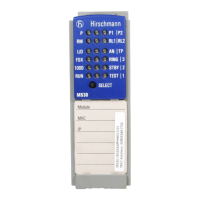Synchronizing the System Time in the
Network
132
7.3
Precision Time Protocol
UM Basic Configuration L3P
Release
7.1
12/2011
Factors influencing precision are:
Accuracy of the reference clock
IEEE 1588 classifies clocks according to their accuracy. An algorithm that
measures the accuracy of the clocks available in the network specifies the
most accurate clock as the "Grandmaster" clock.
Cable delays; device delays
The communication protocol specified by IEEE 1588 enables delays to be
determined. Algorithms for calculating the current time cancel out these
delays.
Accuracy of local clocks
The communication protocol specified by IEEE 1588 takes into account
the inaccuracy of local clocks in relation to the reference clock.
Calculation formulas permit the synchronization of the local time, taking
into account the inaccuracy of the local clock in relation to the reference
clock.
PTPv1
Stratum
number
PTPv2
Clock class
Specification
0 – (priority 1 =
0)
For temporary, special purposes, in order to assign a higher
accuracy to one clock than to all other clocks in the network.
1 6 Indicates the reference clock with the highest degree of
accuracy. The clock can be both a boundary clock and an
ordinary clock. Stratum 1/ clock class 6 clocks include GPS
clocks and calibrated atomic clocks. A stratum 1 clock cannot be
synchronized using the PTP from another clock in the PTP
system.
2 6 Indicates the second-choice reference clock.
3 187 Indicates the reference clock that can be synchronized via an
external connection.
4 248 Indicates the reference clock that cannot be synchronized via an
external connection. This is the standard setting for boundary
clocks.
5–254 – Reserved.
255 255 Such a clock should never be used as the so-called best master
clock.
Table 8: Stratum – classifying the clocks

